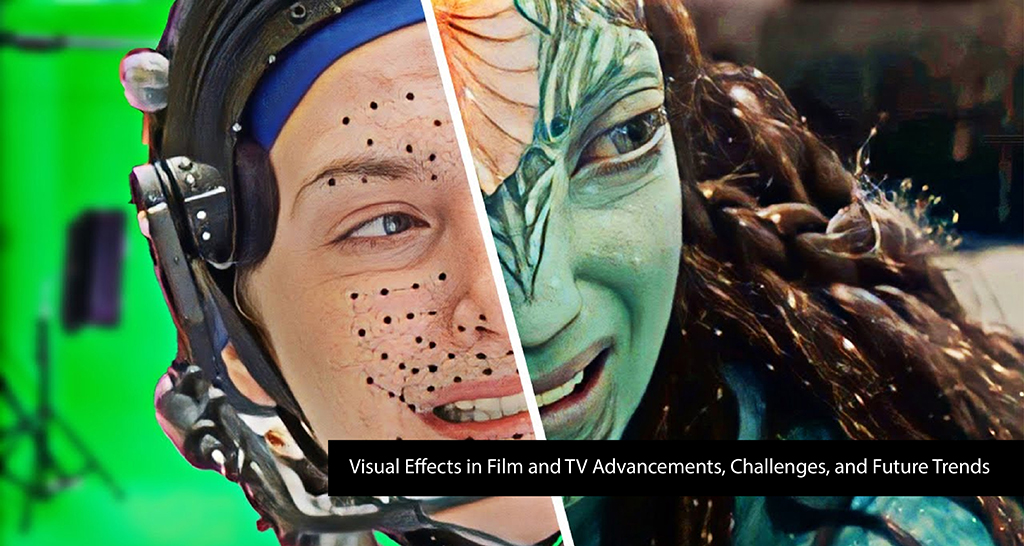Everyone knows about animation, but do you know about VFX? Today we will discuss what VFX is and its advancements, challenges, and future Trends. VFX stands for visual effects in movies and TV, which gives special effects for showing unreal to real.
VFX, or visual effects, is an essential aspect of the entertainment industry today. It involves creating realistic and imaginative visual elements for movies, TV shows, and digital media. VFX can transport audiences to unimaginable realms and enhance the storytelling experience. Special effects in photography and motion pictures can be traced back to the late 19th century when pioneers like Oscar Rejlander and Alfred Clark introduced innovative techniques. Georges Méliès further developed special effects in his films, combining live-action, animation, and intricate miniature work.
Visual effects are based on new technologies. Visual effects (VFX) are advanced digital tools used in creating CGI, compositing, and motion capture for various applications.
Global impact of the VFX industry: The VFX industry has become international due to virtual collaboration during the Covid pandemic. The introduction of streaming platforms such as Disney+, Apple TV+, HBO Max, Peacock, and Paramount+ between 2019 and 2021, in addition to Netflix and Amazon Prime, has collectively enhanced their content production in the industry. Balancing demand and output is essential for sustainability. Episodic content has experienced substantial growth, creating a unique style and extending viewing hours. This VFX trend in demand has led to the establishment of production centers worldwide, with India emerging as a prominent hub for VFX.
Vantage Market Research predicts substantial market growth due to increased demand for high-quality content and advancements in VFX technology. The convergence of gaming workflows, GPU(Graphics Processing Units)-accelerated computing, and cloud computing has made VFX more accessible, enabling its integration into various storytelling mediums. As a result, VFX continues to enhance visual experiences and contribute to the industry’s long-term stability.
Virtual Production and its Influence: Virtual production has revolutionized the VFX industry with the widespread use of LED stages. The market for virtual production is proliferating and is expected to reach $4.73 billion by 2028. Global collaboration between filmmakers and artists from India, China, South Korea, Mexico, Germany, and Australia has become common. The shift from outsourcing to insourcing has led to significant post-production houses establishing studios in India. China has embraced visual effects even in small productions, thanks to advancements in AI, game engines, and virtual LED screen stage shooting. The future is sustaining talent and acquiring creativity by adopting new technologies and skill sets.
Collaboration and Outsourcing in VFX: The association between directors and visual effects teams is essential in film projects. Visual effects are used to enhance storytelling rather than flashy effects. Attention to detail and precision are crucial in overcoming challenges through shooting references and creative problem-solving. Directors use visual effects to convey emotions and create magical or unreal experiences while maintaining a smooth blend with live-action footage. The international nature of visual effects production is evident with contributions from various countries.
The model of visual effects work has shifted from outsourcing to insourcing, with India playing a significant role as major post-production houses establish studios there. The thriving domestic studios handle both local projects and outsourcing work.
DNEG and their Challenges: DNEG (Double Negative), a visual effects vendor, faced the challenge of seamlessly integrating live-action elements with CG in their projects. They successfully incorporated crane shots, extended environments, vehicles, and other elements to create immersive visuals. Balancing Visual interpretation and realism, they aimed to develop original, impactful shots.
Future of the VFX industry:
Technology, virtual production, and global collaborations will transform the VFX industry’s future.
With a focus on enhanced realism, the industry will push the boundaries of visual effects, utilizing CGI, motion capture, and AI to create even more authentic and immersive experiences. The rise of augmented reality and virtual reality will open up new possibilities for storytelling, while global collaborations and outsourcing will bring multiple talents and perspectives to VFX projects. Sustainability, AI automation, and expansion into new media platforms will shape the industry later and offer exciting opportunities for creative expression and innovative ways to capture the audience’s mind. The VFX industry is evolving rapidly, with virtual production, global collaborations, and new technologies shaping its future.
In conclusion, visual effects (VFX) have become essential to movies and TV shows, creating realistic and imaginative visual elements. The industry is rapidly developing with advancements in technology and global collaborations. The future of VFX looks promising, and enhanced realism, virtual production, and new technologies like augmented reality and virtual reality. The industry also explores sustainability and automation while expanding into new media platforms. Exciting opportunities are on the way to capture audiences with innovative visual experiences. The combination of technological advancements, global collaborations, and an intense focus on creativity and storytelling positions the VFX industry for an exciting and transformative future.

